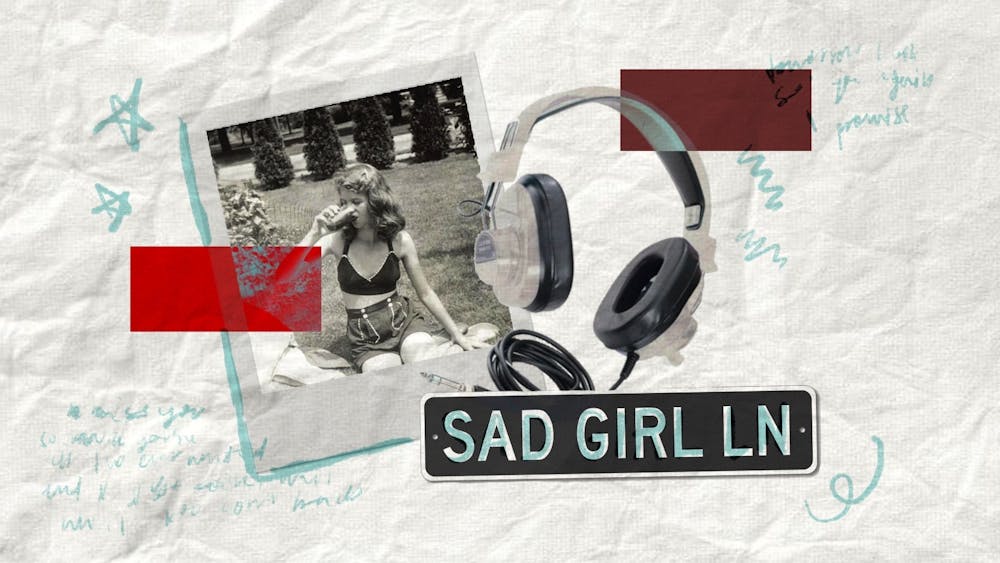Since it first reached American readers in 1971, The Bell Jar has become synonymous with feminine sadness. The novel was revolutionary, following a young Esther Greenwood, a misunderstood and depressed girl walking the tightrope between adolescence and adulthood. As she confronts the oppressive norms of femininity, the expectations of womanhood are so taxing as to quite literally drive her crazy.
Half a century later, the feminine sadness of Esther Greenwood has long endured.
Just turn on the radio.
Taylor Swift tops the charts with, “I think about jumping / Off of very tall somethings / Just to see you come running.”
Arenas of Phoebe Bridgers fans scream out, “Jesus Christ / I’m so blue all the time / And that’s just how I feel / Always have and I always will.”
And at around the same age as Greenwood herself, pop star Olivia Rodrigo sings, “They all say that it gets better, it gets better, but what if I don’t?”
In the wake of her success at the 2024 Oscars, Taylor Swift announced her 11th studio album, The Tortured Poets Department. The title directly evokes the the aura of “sad girl music” has garnered mainstream popularity and a cult following. A moniker popularized by accompanying playlists and memes, sad girl music deals with themes of hopelessness, lost love, disillusionment, and inadequacy. The genre is often associated with indie artists like Mitski, Phoebe Bridgers, and Lana Del Rey, but extends to the mainstream pop of Taylor Swift and Olivia Rodrigo. The music is raw, discussing issues like eating disorders, depression, and the patriarchy with brutal candor. The singers of sad girl music are under no illusions about their lives, willing to display themselves as imperfect and even in the wrong. As Taylor Swift would say, they could even be their own Anti–Hero: “It’s me, hi, I’m the problem it’s me.”
Though a wave of feminism exists between The Bell Jar and The Tortured Poets Department, the modern themes of feminine sadness tread closely to the feelings Plath first illustrated decades ago. While tangible opportunities, such as job prospects and economic freedom, have opened for the modern woman, much of the social reality remains similar. Even today, while it’s conventional for women to work outside the home, female partners often do more work within relationships and are expected to sacrifice their careers. Even if the legal and economic realities have progressed, there still exists an underlying disillusionment about the future for girls standing on the precipice of womanhood. Sad girl music taps into the underlying melancholy of femininity first exposed in The Bell Jar.
Sylvia Plath’s representation of women in The Bell Jar was shocking for its era. Readers of Plath’s novel could hardly fathom the fact that women had a mind of their own, nor that said mind was disillusioned by the world around them. Esther Greenwood was “hysteric” and “mad”; she was not a character read as relatable or representative of girlhood, but one offered up as a voyeuristic look into the disturbing psyche of a tormented young girl. Simply put, Esther Greenwood’s crisis was read as an anomaly, not as a symptom of a larger society. But The Bell Jar was one of many books of third–wave feminism, such as Betty Friedan’s The Feminine Mystique, which exposed this underlying disillusionment and sadness as nearly universal across women from even the most privileged of status.
Today, we’ve largely dropped the belief that women ought to be content operating under a patriarchal system built upon their oppression. Our media is so saturated with images of depressed, anxious, and sad women, that there's nothing shocking about Billie Eillish's lyrics, “if teardrops could be bottled, there’d be swimming pools filled by models.” In fact, it’s expected.
"People just think you're smarter if you're sad," says Phoebe Bridgers, speaking to her difficulty writing happy music as a female singer in the modern music industry. To not be in despair, one would argue, is to be ignorant of the systemic issues and societal standards at play. The girls should be sad, right?
Unlike The Bell Jar’s Esther Greenwood who serves as a warning, sad girl music is supposed to be relatable in a society where feminine despair has become the norm.
Yes, they sing, it is terrible that we have to starve ourselves to be seen as beautiful. Yes, it is terrible that the media objectifies us. Yes, it is terrible to be a woman within the modern patriarchy. And we sing along in agreement, admitting that we too are disillusioned and tired, never questioning why we’ve accepted this sadness in the first place.
As of 2023, the CDC reports that 3 out of 5 girls experience intense feelings of despair, a number on the rise. Sad girl music or The Bell Jar aren’t the problem; they are simply reflections of modern experiences. The issue is our perspective, where we’ve acquiesced to simply expect girlhood to result in torture. Rather than being moved to remedy or surprise, the conditions of feminine sadness have been accepted as inevitable, as if it is impossible for girls to ever leave The Tortured Poets Department.

